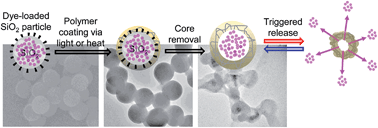A strategy to design biocompatible polymer particles possessing increased loading efficiency and controlled-release properties
Abstract
Temperature-responsive poly(N-isopropylacrylamide), or poly(NIPAM), layers were reliably prepared around guest molecule (i.e., rhodamine B)-loaded mesoporous silica (SiO2) particles via thermally- and light-induced radical polymerizations. Subsequent removal of the sacrificial SiO2 particles with dilute hydrofluoric acid led to the formation of biocompatible polymer particles possessing a high dose of rhodamine B. The use of SiO2 core templates not only led to the formation of a uniform coating of the poly(NIPAM) layers, but also increased the stability of the guest molecule, rhodamine B, throughout polymerization. Interestingly, the light-induced radical polymerization method resulted in much less inevitable leaching and decomposition of azo-based guest molecules. The structural information and overall dye-loading efficiency of the mesoporous particles and the final polymer particles were then thoroughly examined by electron microscopes, dynamic light scattering, and fluorescence spectroscopy. As poly(NIPAM)-based particles exhibited significant swelling and deswelling properties above and below the lower critical solution temperature, the controlled-release properties of the poly(NIPAM) particles prepared by both methods were also evaluated. Generally, the dye-loaded poly(NIPAM) particles prepared by the light-induced approach resulted in a thinner coating of the polymer layers and exhibited much higher loading and tunable release profiles of the loaded guest molecules than those prepared by the thermally-induced polymerization. Given these features, the generalization of our strategy to design chemotherapeutically interesting drug-loaded polymer particles that are biocompatible and sensitive to external stimuli will allow for the further development of novel biomedical delivery and treatment systems.


 Please wait while we load your content...
Please wait while we load your content...